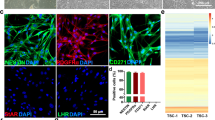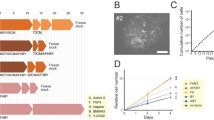Abstract
NUMEROUS attempts to reproduce the malformations which occurred in human babies from ‘Thalidomide’-treated mothers have met with only limited success1–3. Although many representatives of aves and mammalian experimental species have been investigated for this purpose, the results fall short of paralleling the effect of the drug on the human foetus4. Sub-human primates have been utilized on two occasions5,6. Lucey and Behrmann5 showed that treating rhesus monkeys with ‘Thalidomide’ before implantation resulted in the inhibition of implantation. Delahunt and Lassen6 induced typically malformed foetuses in four of seven pregnant Cynomolgus monkeys which were treated after implantation had already occurred (days 32–42). Although the embryology of the baboon has not been investigated as extensively as that of some other sub-human primates, developmental processes paralleling those in the human have been found7. Further investigation of the embryology is in progress.
This is a preview of subscription content, access via your institution
Access options
Subscribe to this journal
Receive 51 print issues and online access
$199.00 per year
only $3.90 per issue
Buy this article
- Purchase on Springer Link
- Instant access to full article PDF
Prices may be subject to local taxes which are calculated during checkout
Similar content being viewed by others
References
Klein Obbink, H. J., and Dalderup, L. M., Experientia, 20, 283 (1964).
Hay, M. F., J. Reprod. Fertil., 8, 59 (1964).
Dekker, A., and Mehrizi, A., Bull. Johns Hopkins Hosp., 115, 233 (1964).
Somers, G. F., Proc. Europ. Soc. Study of Drug Toxicity, 49 (1963).
Lucey, J. F., and Behrmann, R. E., Science, 139, 1295 (1963).
Delahunt, C. S., and Lassen, L. J., Science, 146, 1300 (1964).
Gilbert, C., and Heuser, C. H., Carnegie Inst., Washington, Contrib. Embryol., 35, 11 (1954).
Fishbein, M., Birth Defects, 181 (J. B. Lippincott Co., Philadelphia, 1963).
Taussig, H. B., J. Amer. Med. Soc., 180, 1105 (1962).
Hendrickx, A. G., Anat. Rec., 151, 488 (1965).
Marin-Padilla, M., Anat. Rec., 149, 359 (1964).
Marin-Padilla, M., and Benirschke, K., Amer. J. Pathol., 43, 999 (1963).
Lutwak-Mann, C., and Hay, M. F., Brit. Med. J., ii, 944 (1962).
Author information
Authors and Affiliations
Rights and permissions
About this article
Cite this article
HENDRICKX, A., AXELROD, L. & CLAYBORN, L. ‘Thalidomide’ Syndrome in Baboons. Nature 210, 958–959 (1966). https://doi.org/10.1038/210958a0
Issue Date:
DOI: https://doi.org/10.1038/210958a0
This article is cited by
-
Embryotoxic effects of thalidomide derivatives in the non-human primate Callithrix jacchus
Archives of Toxicology (1988)
Comments
By submitting a comment you agree to abide by our Terms and Community Guidelines. If you find something abusive or that does not comply with our terms or guidelines please flag it as inappropriate.



